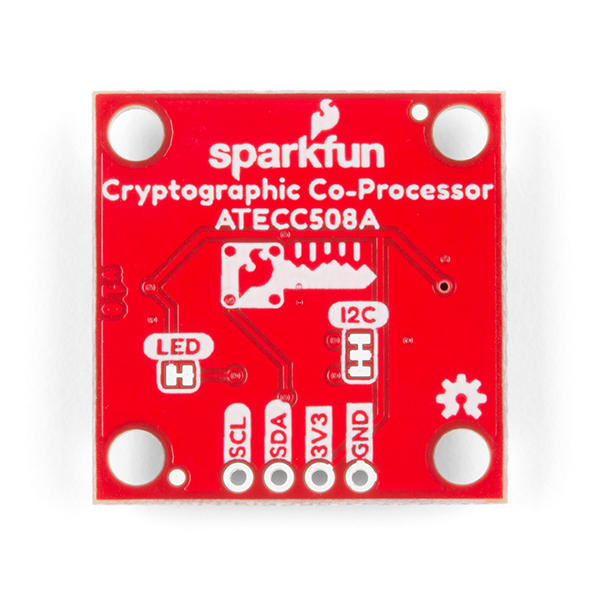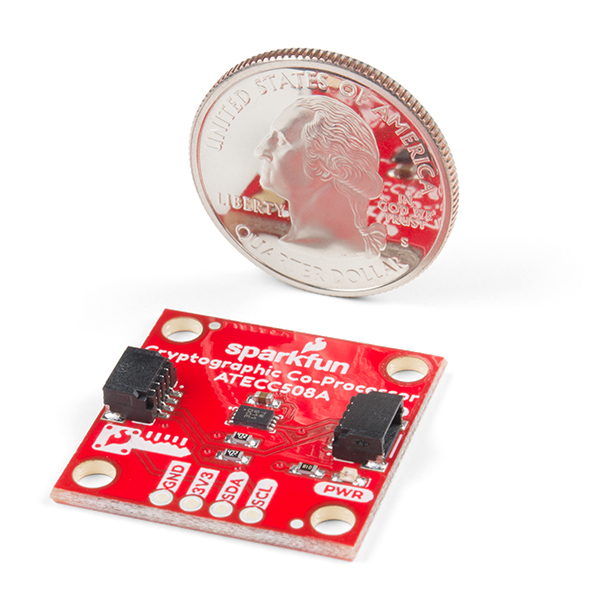SparkFun Cryptographic Co-Processor Breakout - ATECC508A (Qwiic)
The SparkFun ATECC508A Cryptographic Co-Processor Breakout allows you to easily add strong authentication security to your IoT node, edge device, or embedded system. It includes two Qwiic ports for plug and play functionality. Utilizing our handy Qwiic system, no soldering is required to connect it to the rest of your system. However, we still have broken out 0.1"-spaced pins in case you prefer to use a breadboard. The ATECC508A chip is capable of many cryptographic processes, including, but not limited to:
- Creating and securely storing unique asymmetric key pairs based on Elliptic Curve Cryptography (FIPS186-3).
- Creating and verifying 64-byte digital signatures (from 32-bytes of message data).
- Creating a shared secret key on a public channel via Elliptic Curve Diffie-Hellman Algorithm.
- A standard hash-based challenge-response protocol using a SHA-256 algorithm.
- Internal high quality FIPS random number generator.
Embedded in the chip is a 10Kb EEPROM array that can be used for storing keys, certificates, data, consumption logging, and security configurations. Access to the sections of memory can then be restricted and the configuration locked to prevent changes.
Each ATECC508A ships with a guaranteed unique 72-bit serial number and includes several security features to prevent physical attacks on the device itself, or logical attacks on the data transmitted between the device.
Our hookup guide and Arduino Library (which includes six examples) will get you familiar with the basics of elliptic curve cryptography and signing/verifying data in no time!
🔒 Note: Please read through the hookup guide in its entirety before using this board. The chip can be only configured before it is PERMANENTLY locked. It is advisable that users purchase multiple boards in order to use other configurations and explore the advanced functions of the ATECC508A.
Additionally, this board is NOT capable of encrypting and decrypting data. It can however, perform quite a few cryptographic authentication processes such as secure private key creation, secure key storage, and digital signature creation and verification.
It is recommended that an Artemis microcontroller board is used with this product due to the buffer size required on the I2C bus.
The SparkFun Qwiic Connect System is an ecosystem of I2C sensors, actuators, shields and cables that make prototyping faster and less prone to error. All Qwiic-enabled boards use a common 1mm pitch, 4-pin JST connector. This reduces the amount of required PCB space, and polarized connections mean you can’t hook it up wrong.
- Operating Voltage: 2.0V-5.5V (Default on Qwiic System: 3.3V)
- Active Current Draw (for ATECC508A): 16 mA
- Sleep Current (for ATECC508A): <150 nA
- Guaranteed Unique 72-bit Serial Number
- 10 Kb EEPROM Memory for Keys, Certificates, and Data
- Storage for up to 16 Keys
- 256-bit Key Length
- Internal High-Quality FIPS Random Number Generator (RNG)
- Configurable I2C Address (7-bit): 0x60 (Default)
SparkFun Cryptographic Co-Processor Breakout - ATECC508A (Qwiic) Product Help and Resources
Cryptographic Co-Processor ATECC508A (Qwiic) Hookup Guide
October 17, 2019
Learn how to use some of the standard features of the SparkFun Cryptographic Co-processor.
Secure DIY Garage Door Opener
January 16, 2020
Did you know that most garage doors are at risk of a roll jam attack? Here we make a DIY garage door remote-control system that is much more secure than most commercial-ready products using the latest in ECC cryptography.
Core Skill: Programming
If a board needs code or communicates somehow, you're going to need to know how to program or interface with it. The programming skill is all about communication and code.
Skill Level: Competent - The toolchain for programming is a bit more complex and will examples may not be explicitly provided for you. You will be required to have a fundamental knowledge of programming and be required to provide your own code. You may need to modify existing libraries or code to work with your specific hardware. Sensor and hardware interfaces will be SPI or I2C.
See all skill levels
Core Skill: Electrical Prototyping
If it requires power, you need to know how much, what all the pins do, and how to hook it up. You may need to reference datasheets, schematics, and know the ins and outs of electronics.
Skill Level: Rookie - You may be required to know a bit more about the component, such as orientation, or how to hook it up, in addition to power requirements. You will need to understand polarized components.
See all skill levels
Comments
Looking for answers to technical questions?
We welcome your comments and suggestions below. However, if you are looking for solutions to technical questions please see our Technical Assistance page.
Customer Reviews
No reviews yet.




